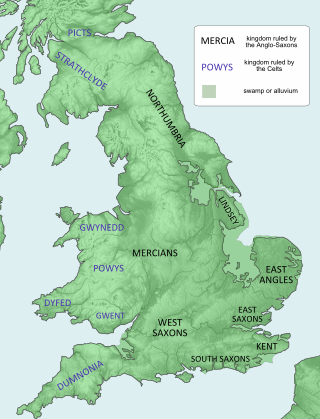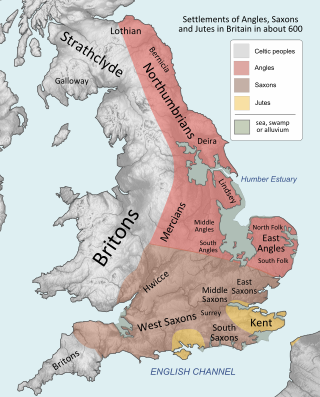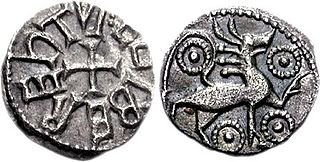Related Research Articles

Ceawlin was a King of Wessex. He may have been the son of Cynric of Wessex and the grandson of Cerdic of Wessex, whom the Anglo-Saxon Chronicle represents as the leader of the first group of Saxons to come to the land which later became Wessex. Ceawlin was active during the last years of the Anglo-Saxon expansion, with little of southern England remaining in the control of the native Britons by the time of his death.

Ine, also rendered Ini or Ina, was King of Wessex from 689 to 726. At Ine's accession, his kingdom dominated much of southern England. However, he was unable to retain the territorial gains of his predecessor, Cædwalla, who had expanded West Saxon territory substantially. By the end of Ine's reign, the kingdoms of Kent, Sussex, and Essex were no longer under West Saxon sway; however, Ine maintained control of what is now Hampshire, and consolidated and extended Wessex's territory in the western peninsula.

Coenred was king of Mercia from 704 to 709. Mercia was an Anglo-Saxon kingdom in the English Midlands. He was a son of the Mercian king Wulfhere, whose brother Æthelred succeeded to the throne in 675 on Wulfhere's death. In 704, Æthelred abdicated in favour of Coenred to become a monk.

Wiglaf was King of Mercia from 827 to 829 and again from 830 until his death. His ancestry is uncertain: the 820s were a period of dynastic conflict within Mercia and the genealogy of several of the kings of this time is unknown. Wigstan, his grandson, was later recorded as a descendant of Penda of Mercia, so it is possible that Wiglaf was descended from Penda, one of the most powerful seventh-century kings of Mercia.

Cædwalla was the King of Wessex from approximately 685 until he abdicated in 688. His name is derived from the Welsh Cadwallon. He was exiled from Wessex as a youth and during this period gathered forces and attacked the South Saxons, killing their king, Æthelwealh, in what is now Sussex. Cædwalla was unable to hold the South Saxon territory, however, and was driven out by Æthelwealh's ealdormen. In either 685 or 686, he became King of Wessex. He may have been involved in suppressing rival dynasties at this time, as an early source records that Wessex was ruled by underkings until Cædwalla.
Cenwalh, also Cenwealh or Coenwalh, was King of Wessex from c. 642 to c. 645 and from c. 648 until his death, according to the Anglo-Saxon Chronicle, in c. 672.
Ceolwulf II was the last king of independent Mercia. He succeeded Burgred of Mercia who was deposed by the Vikings in 874. His reign is generally dated 874 to 879 based on a Mercian regnal list which gives him a reign of five years. However, D. P. Kirby argues that he probably reigned into the early 880s. By 883, he was replaced by Æthelred, Lord of the Mercians, who became ruler of Mercia with the support of Alfred the Great, king of Wessex.

Cynegils was King of Wessex from c. 611 to c. 642. Cynegils is traditionally considered to have been King of Wessex, even though the kingdoms of the Heptarchy had not yet formed from the patchwork of smaller kingdoms in his lifetime. The later kingdom of Wessex was centred on the counties of Hampshire, Dorset, Somerset and Wiltshire but the evidence of the Anglo-Saxon Chronicle is that the kingdom of Cynegils was located on the upper River Thames, extending into northern Wiltshire and Somerset, southern Gloucestershire and Oxfordshire, and western Berkshire, with Dorchester-on-Thames as one of the major royal sites. This region, probably connected to the early tribal grouping known as the Gewisse, a term used by Bede for the West Saxons, lay on the frontier between the later kingdoms of Wessex and Mercia.
The Gewisse were a tribe or clan of Anglo-Saxon England, historically assumed to have been based in the upper Thames region around Dorchester on Thames. The Gewisse are one of the direct precursors of modern-day England, being the origin of its predecessor states according to Saxon legend.
Centwine was King of Wessex from c. 676 to 685 or 686, although he was perhaps not the only king of the West Saxons at the time.
Æscwine was a King of Wessex from about 674 to 676, but was probably not the only king in Wessex at the time.
Seaxburh was a queen of Wessex. She is also called Queen of the Gewisse, an early name for the tribe which ruled Wessex. She is said to have ruled Wessex for between one and two years after the death of her husband, Cenwalh, in 672. Her accession to the throne is documented in the Anglo-Saxon Chronicle for that year which states that 'This year king Kenwalk died, and Sexburga his queen reigned one year after him'. It was extremely rare for a woman to rule in suo jure in Anglo-Saxon England, and she was one of the only women to appear in a regnal list. She may have ruled for over a year, as the next reign is entered in the Anglo-Saxon Chronicle in 674.
Ceol is portrayed by the Anglo-Saxon Chronicle and West Saxon Genealogical Regnal List as King of Wessex for five to six years around 592 to 597 or 588 to 594.

Cwichelm was an Anglo-Saxon king of the Gewisse, a people in the upper Thames area who later created the kingdom of Wessex. He is usually counted among the Kings of Wessex.

Eadberht was king of Northumbria from 737 or 738 to 758. He was the brother of Ecgbert, Archbishop of York. His reign is seen as a return to the imperial ambitions of seventh-century Northumbria and may represent a period of economic prosperity. He faced internal opposition from rival dynasties and at least two actual or potential rivals were killed during his reign. In 758 he abdicated in favour of his son Oswulf and became a monk at York.
Saint Ceolwulf was King of Northumbria from 729 until 737, except for a short period in 731 or 732 when he was deposed and quickly restored to power. Ceolwulf abdicated and entered the monastery at Lindisfarne. He was the "most glorious king" to whom Bede dedicated his Historia ecclesiastica gentis Anglorum.

Æthelweard was a 9th-century king of East Anglia, the long-lived Anglo-Saxon kingdom which today includes the English counties of Norfolk and Suffolk. Little is known of Æthelweard's reign and even his regnal dates are not known for certain. He was succeeded by Edmund, who was said to have been crowned on 25 December 854.
Cuthwine, born c. 565, was a member of the House of Wessex, the son of King Ceawlin of Wessex. Cuthwine's father Ceawlin was deposed from the throne of Wessex in 592 by his nephew Ceol. Therefore, Cuthwine never inherited the throne. Cuthwine went into exile for many decades, remaining a strong leader of the Saxons and passing on the royal line through his three sons.
Cenred of Wessex was a member of the House of Wessex and a member of the direct male line from Cynric to Egbert. It is possible that Cenred ruled alongside his son Ine for a period. There is weak evidence for joint kingships, and stronger evidence of subkings reigning under a dominant ruler in Wessex, not long before his time. Ine acknowledges his father's help in his code of laws, and there is also a surviving land-grant that indicates Cenred was still reigning in Wessex after Ine's accession.
Cuthwulf, also sometimes Cutha, was the third son of Cuthwine, and consequently a member of the House of Wessex. Although a member of the direct male line from Cynric to Egbert, Cuthwulf was never king. He is said to have been born circa 592, and his death date is unknown.
References
- 1 2 3 4 Yorke, Ceolwulf
- 1 2 Kirby 2000, p. 46.
- ↑ Yorke 1990, pp. 133–135.
- ↑ Kirby 2000, p. 43.
- ↑ Yorke 1990, pp. 134–135.